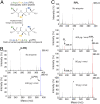From combinatorial peptide selection to drug prototype (I): targeting the vascular endothelial growth factor receptor pathway
- PMID: 20190181
- PMCID: PMC2841949
- DOI: 10.1073/pnas.0915141107
From combinatorial peptide selection to drug prototype (I): targeting the vascular endothelial growth factor receptor pathway
Abstract
Inhibition of blood vessel formation is a viable therapeutic approach in angiogenesis-dependent diseases. We previously used a combinatorial screening on vascular endothelial growth factor (VEGF)-activated endothelial cells to select the sequence CPQPRPLC and showed that the motif Arg-Pro-Leu targets VEGF receptor-1 and neuropilin-1. Here, we evaluated and validated (D)(LPR), a derivative molecule with strong antiangiogenesis attributes. This prototype drug markedly inhibits neovascularization in three mouse models: Matrigel-based assay, functional human/murine blood vessel formation, and retinopathy of prematurity. In addition to its systemic activity, (D)(LPR) also inhibits retinal angiogenesis when administered in an eye-drop formulation. Finally, in preliminary studies, we have showed targeted drug activity in an experimental tumor-bearing mouse model. These results show that drugs targeting extracellular domains of VEGF receptors are active, affect signal transduction, and have potential for clinical application. On a larger context, this study illustrates the power of ligand-directed selection plus retro-inversion for rapid drug discovery and development.
Conflict of interest statement
The authors declare no conflict of interest.
Figures






Similar articles
-
Discovery of pan-VEGF inhibitory peptides directed to the extracellular ligand-binding domains of the VEGF receptors.Sci Adv. 2016 Oct 28;2(10):e1600611. doi: 10.1126/sciadv.1600611. eCollection 2016 Oct. Sci Adv. 2016. PMID: 27819042 Free PMC article.
-
Structural basis for the interaction of a vascular endothelial growth factor mimic peptide motif and its corresponding receptors.Chem Biol. 2005 Oct;12(10):1075-83. doi: 10.1016/j.chembiol.2005.07.008. Chem Biol. 2005. PMID: 16242650
-
From combinatorial peptide selection to drug prototype (II): targeting the epidermal growth factor receptor pathway.Proc Natl Acad Sci U S A. 2010 Mar 16;107(11):5118-23. doi: 10.1073/pnas.0915146107. Epub 2010 Feb 26. Proc Natl Acad Sci U S A. 2010. PMID: 20190183 Free PMC article.
-
Mammalian Target of Rapamycin (mTOR) as a Potential Therapeutic Target in Pathological Ocular Angiogenesis.Biol Pharm Bull. 2017;40(12):2045-2049. doi: 10.1248/bpb.b17-00475. Biol Pharm Bull. 2017. PMID: 29199229 Review.
-
Role of the vascular endothelial growth factor isoforms in retinal angiogenesis and DiGeorge syndrome.Verh K Acad Geneeskd Belg. 2005;67(4):229-76. Verh K Acad Geneeskd Belg. 2005. PMID: 16334858 Review.
Cited by
-
A transcriptome-based signature of pathological angiogenesis predicts breast cancer patient survival.PLoS Genet. 2019 Dec 17;15(12):e1008482. doi: 10.1371/journal.pgen.1008482. eCollection 2019 Dec. PLoS Genet. 2019. PMID: 31846472 Free PMC article.
-
Topoisomeric Membrane-Active Peptides: A Review of the Last Two Decades.Pharmaceutics. 2023 Oct 12;15(10):2451. doi: 10.3390/pharmaceutics15102451. Pharmaceutics. 2023. PMID: 37896211 Free PMC article. Review.
-
IKKβ targeting reduces KRAS-induced lung cancer angiogenesis in vitro and in vivo: A potential anti-angiogenic therapeutic target.Lung Cancer. 2019 Apr;130:169-178. doi: 10.1016/j.lungcan.2019.02.027. Epub 2019 Feb 25. Lung Cancer. 2019. PMID: 30885340 Free PMC article.
-
Peptide phage display as a tool for drug discovery: targeting membrane receptors.Molecules. 2011 Jan 21;16(1):857-87. doi: 10.3390/molecules16010857. Molecules. 2011. PMID: 21258295 Free PMC article. Review.
-
Ligand-targeted theranostic nanomedicines against cancer.J Control Release. 2016 Oct 28;240:267-286. doi: 10.1016/j.jconrel.2016.01.002. Epub 2016 Jan 6. J Control Release. 2016. PMID: 26772878 Free PMC article. Review.
References
-
- Folkman J. Tumor angiogenesis: Therapeutic implications. N Engl J Med. 1971;285:1182–1186. - PubMed
-
- Folkman J. Angiogenesis: An organizing principle for drug discovery? Nat Rev Drug Discov. 2007;6:273–286. - PubMed
-
- Carmeliet P. Angiogenesis in life, disease and medicine. Nature. 2005;438:932–936. - PubMed
-
- Loges S, Roncal C, Carmeliet P. Development of targeted angiogenic medicine. J Thromb Haemost. 2009;7:21–33. - PubMed
Publication types
MeSH terms
Substances
LinkOut - more resources
Full Text Sources
Other Literature Sources

